SCEA PlayStation Home Top-Ten Items (By Number of Units Sold) For June, 2012
Information provided by Cade Peterson, PlayStation Digital Platforms Community Manager; commentary and analysis by NorseGamer, HSM Editor-in-Chief
Strange to think that a month ago, I was writing this at about four in the morning from a Starwood hotel room, getting ready for E3. And now I’m back in my sleepy outer island in Hawaii, the past month a blur that feels like a dream from another lifetime.
The weird thing about the E3 experience — before we dive into this month’s list — is that the expo itself wasn’t really the highlight. It was fun, sure, but really all you’re doing is playing demos of games that won’t be out until next year. So it gives you the bragging rights to say you tried Metal Gear Androgyny, Assassin’s Creed Pirate Wench, Lara Croft Mammary Raider, Hitman: Even More Pwnage, FarCry Technicolor, Star Trek 3D-OMG-BOOM, and so forth. But what made the trip worth it was getting to hang out with the legitimately awesome developers who work on the Home platform. Spending a week hanging out with Lockwood, LOOT, Hellfire, Heavy Water, Game Mechanics and the SCEA Digital Platforms guys is really what made the trip memorable and fun.
And, of course, if you ever get a chance to hang out with Cubehouse, do it. Cubes is a BMW M5: insane amounts of technology packed under the hood, but without any of the shouty pretentiousness of his would-be competitors. And you make the mistake of thinking, “Oh, it’s just another Beemer,” and you forget that this is the guy who wrote Facebook Chess and gets paid to break into banks for a living, and suddenly you have just been whomped off the line and you’re left staring at his tire tracks. And you realize he never even bothered to leave second gear.
So, yeah, surprises abound. Just as these top-ten sales lists from SCEA surprise me. Take a look, and let’s dive in.
1. Tokens, chips and tickets. Oh my.
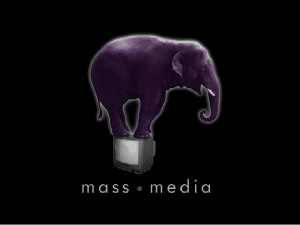 Once again, Mass Media, Digital Leisure and Lockwood have locked up nearly half of this list with their tickets, chips and tokens, respectively. In the case of the Lockwood tokens, this makes perfect sense: we’ve analyzed the Lockwood Gift Machine repeatedly in HSM because it’s such a brilliant strategy that we’re amazed no one else has latched onto it. Whether the majority of the token sales are coming from people buying gifts for others, or people creating alternate accounts to gift themselves, it’s a smart strategy that combines rewards with social interaction. In other words, it plays to Home’s strength as a social network for gamers.
Once again, Mass Media, Digital Leisure and Lockwood have locked up nearly half of this list with their tickets, chips and tokens, respectively. In the case of the Lockwood tokens, this makes perfect sense: we’ve analyzed the Lockwood Gift Machine repeatedly in HSM because it’s such a brilliant strategy that we’re amazed no one else has latched onto it. Whether the majority of the token sales are coming from people buying gifts for others, or people creating alternate accounts to gift themselves, it’s a smart strategy that combines rewards with social interaction. In other words, it plays to Home’s strength as a social network for gamers.
But let’s talk about the Green Ticket and the Casino chips for a moment. Remember, these lists are compiled by number of units sold, not by sales volume. Hasn’t anyone else found it strange how blatantly high-performing these two commodities are, especially when other games are rolled out into Home and don’t even chart?
And then it hit me: Mass Media and Digital Leisure aren’t “splitting the vote” with their commodities.
Think about it. If you go to most any major game in Home — Sodium2, Novus Prime, Cutthroats, No Man’s Land, etc. — there’s a whole wealth of commodities to choose from. This effectively splits the vote; you might have a tremendous amount of commerce taking place for your game, but since it’s so broadly diversified, you’ll never have any one commodity selling in sufficient numbers to chart. These developers offer a wealth of enhancements for one gaming experience — whereas Mass Media and Digital Leisure offer one commodity for a variety of gaming experiences. There’s no vote splitting.
Christ, is it any wonder they’re topping the charts?
The reason why this is so important is that the charts may be sending back a false positive. A business analyst looking solely at this chart would recommend to a game developer to structure a Home game with limited-use temporary commodities that can be acquired for simple and repetitive gaming experiences that offer scaling difficulty and fast action-to-reward times. And while that may be one formula for gaming success in Home, it is hardly the only approach — nor is it necessarily the approach which offers the most compelling games.
 To be clear: I have nothing against Mass Media or Digital Leisure. They have successful business strategies which capitalize upon a good percentage of Home’s gaming population, and they deserve all the revenue they’re earning. But I sincerely hope there’s a lot more business guidance being offered to developers than just this particular chart, because it’s only painting a semi-accurate picture.
To be clear: I have nothing against Mass Media or Digital Leisure. They have successful business strategies which capitalize upon a good percentage of Home’s gaming population, and they deserve all the revenue they’re earning. But I sincerely hope there’s a lot more business guidance being offered to developers than just this particular chart, because it’s only painting a semi-accurate picture.
By way of example: in resort development, I could measure my sales team’s performance according to three primary metrics: average contract price, efficiency or sales volume. We had other metrics as well — customer satisfaction and average tour duration being quite important — but those were the big three. If I looked solely at sales volume, for instance, a couple of people always stood out as top performers; but if I looked at the same group of people by efficiency (volume divided by number of clients), a very different picture could emerge. Sometimes the best salesman was the one who didn’t necessarily have the highest sales volume, but was closing such a higher percentage of people at a decent average contract price that he was actually costing the company less money with his productivity.
 (I am available for children’s parties, by the way. Spreadsheets With Norse!)
(I am available for children’s parties, by the way. Spreadsheets With Norse!)
In order to get a much more accurate picture of what’s really dominating the Home mictotransaction scene — particularly for gaming, since that’s the direction Home is headed in — there needs to be another data point. Specifically, a chart sorted by sales volume, not number of units sold, so that the two can be contrasted. I’m not holding my breath for that one. I just hope that there’s a good amount of data being provided to Home’s third-party developers, who are making up an increasing percentage of Home’s market share. Because we do need to discuss something which isn’t on this list:
2. Awesome games that never charted.
I don’t go to the Casino. I don’t play the Midway games. They’re just not my thing. I have nothing against them and they have earned their success. They are well-engineered spaces which run smoothly and provide hours upon hours of entertainment for a lot of people.
If you follow these lists every month, it’d be easy to come to the conclusion that the road to the promised land relies on low-priced, limited-use items for relatively simple games that reward people in a hurry. And this bugs me, because if that’s what developers start to think is the path to success, we’re going to see fewer Home games which are complex, deeply engrossing, and push the limits of what the platform can do.
Let’s look at some examples. Novus Prime is considered a clinic on how to run a successful freemium game in Home. It’s built to be entertaining for years on end. Guess how many times it charted.
Once.
Specifically, in its launch month, its Nebulon boosters (a temporary item) inched into the bottom of that month’s sales list. And never reappeared.
Let’s use an even more egregious example. Sodium2 never charted. Not once. Ever, at all, for anything.
Are these games commercial failures? Absolutely not. If anything, they’re huge, high-profile successes — but you wouldn’t know it if this was the only data point you had to look at. And the reason why this is important is that these games offer one type of experience and then a variety of enhancements for it. While this splits the vote and keeps any one item off the top-ten list, I will argue that it leads to equal (if not greater) aggregate sales volume. And this is a good thing, because that encourages developers to continue pushing the envelope with more intricate and involved gaming experiences, as opposed to basic arcade amusements.
Case in point: No Man’s Land. This game hasn’t been a critical darling because of its deviations from the “Home formula” for freemium gaming, but because all the power-ups are permanent and clearly-visible, it gives an observer a chance to see (albeit in a very limited scope) what percentage of players are upgrading, and to what extent. And you might just be surprised how many of those fifty-dollar bundles have been purchased.
Is it a game I’m rooting for? Yeah. I happen to personally like it. It’s a game that doesn’t rely on gimmicks like free rewards to keep you playing, and takes the risk that the gameplay itself is sufficiently compelling. I like that. It’s a gutsy move that gives the finger to a growing attitude of entitlement that someone should receive free rewards just for showing up and playing. The message is quite clear: either hone your skills or pony up a few bucks if you think it’s unfair that your free gaming experience causes you to die so often. And gamers (particularly shooter enthusiasts), being the competitive sort, will lay out something — even if it’s just $1.49 — to get a better gun. Mission accomplished.
(Now, if they could just fix the damn bug that keeps freezing game sessions, we’d be golden.)
No Man’s Land didn’t chart. Like Sodium2 and Novus Prime before it. But these are all successful games. I have little doubt SCEA provides a wealth of information, sorted in a variety of ways, to all the developers out there; my only contribution on this matter would be to encourage developers to keep pushing the boundaries with more complex games, such as Mercia and Home Tycoon, even if they don’t show up on this particular chart.
Holy bleep, a personal estate showed up on a top-ten sales list? And it made it into the top half of the list? Where’d that come from? We haven’t seen a personal estate chart like that in a long time, particularly given how saturated the market is.
What prompted so many people to pick up the Private Hideaway? I’m a sucker for nature-themed spaces (particularly tropical ones, for obvious reasons), but why did this particular space do so well, considering the Tropical Bungalow didn’t chart? Is it the near-seamless integration with a public space, making it feel connected to something larger? Is it the beauty of the scenic vistas? Is it the novelty of being able to sit on the roof? You tell me. It’s very impressive to see a private estate chart at all today, let alone so high up on the list.
Just for kicks, I’m throwing in one of my all-time favorite movie scenes, just because it captures the emotional thrill of visiting a true private hideaway:
Unfortunately, the scene cuts off right before the last bit of dialogue:
“This must go over well,” Catherine murmurs.
“With whom?” Thomas asks.
“Whomever you bring here…”
(Walking into the house, not looking back at her) “I never bring anyone here.”
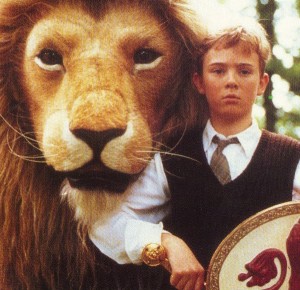 4. C. S. Lewis would be proud.
4. C. S. Lewis would be proud.
Kiburi the Lion sure is popular! It’s not hard to see why. He’s a big companion — and the trend has been towards larger ones for some time now — but it’s also like having your own personal Aslan. Except Kiburi is white. Which makes him even more awesome. It’s like how Gandalf the White was so much more badass than Gandalf the Grey. If Kiburi had been in the Narnia novels, you’d have the White Witch versus the White Lion. If Kiburi had been in Jaws, you’d have a Great White versus a White lion, and the screen would simply have exploded from how much epic win was crammed onto it.
My point? Lockwood is awesome. Particularly since Lockwood’s logo has two lions in it. And now their lion companion just tore up the charts. In the words of the Old Spice guy, “DOUBLE SUN POWER!”
5. Men’s “fashion” is back.
So, after virtual clothing nearly disappearing from these lists, it’s back in a big way — male clothing, anyway (somebody tell those primadonna cross-dressing fashionistas that they need to stick up for the gender they pretend to be!). The only newsworthy item here is the fact that two of the items — the high-tops and the shirt/tattoo combination — actually charted for the second month in a row.
Okay, this clearly isn’t a fluke. Making it onto one of these charts once isn’t easy. Charting two months in a row is remarkable. The problem is that I’m ill-equipped to analyze these two clothing items; they don’t appeal to me and I don’t really understand the target audience they’re designed for. Who’s buying this stuff, and why? I’m genuinely curious to know.
Looking forward, what can we expect to see?
Well, nDreams has a pretty huge announcement coming up shortly, and I suspect it’s going to be a megahit. Looking further out, there’s Mercia and Home Tycoon, which are both hotly-anticipated games which should bring in a lot of revenue. LOOT’s portable EOD will be a smash hit. And Heavy Water has something cooking which genuinely excites me. The way this list is sorted, Mass Media and Digital Leisure will have a lock on the top slots for many months to come, but I’m frankly curious to see who else will crack onto this list in the second half of 2012.


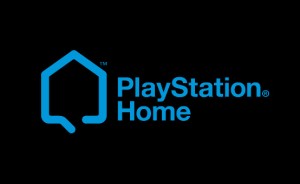
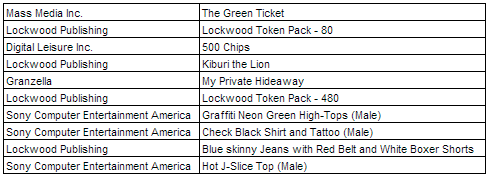
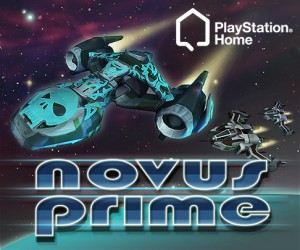
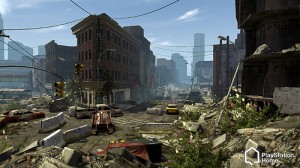
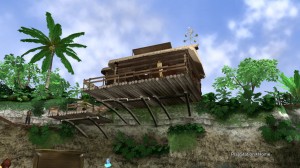
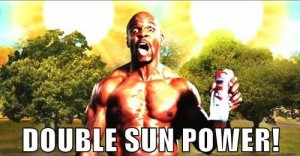
 LinkedIn
LinkedIn Twitter
Twitter
Kiburi was omnipresent during E3, which is part of the reason I bought one of the other companions. That and I’m not a huge White Lion fan…I mean, c’mon, “Wait” is a good song and all, but it’s not exactly metal.
There’s an obvious reason why My Personal Hideaway is on the list, and that’s the second fossil digging site that it opens. Granzella seems to have struck a chord with that game. We apparently like daily tasks that can serve up a lot of rewards.
my personnel hideaway also tends to our need to be in an area others cant get to, lets wave at the people that cant get here, bit like the masses that stand behind the rope at x7, as for micro transactions its a facebook or zyngo thing, make simple addictive games with small often transactions, home is just a different type of facebook really.
@You two chappies above me, I’d say it’s probably both. Granzellas fossil game reminds me of Animal Crossing though, I remember being absolutely hooked on it for the DS, and fossil digging was a massive part of it. The genius of it however, was in being able to link two machines together and not just visit friends towns, but swapping fossils to finish off the last bits of your personal museum. That game rocked, it even let me draw me and my girlfriends initials in the stars for her. Oops, back on topic…
“I don’t play the Midway games. They’re just not my thing. I have nothing against them and they have earned their success. They are well-engineered spaces which run smoothly and provide hours upon hours of entertainment for a lot of people”
I’m sorry Norse but, have you ever even been there!? Haha! They’ve gotta be the single WORST spaces ever made, evuuur! Don’t get me wrong, I’ve had a lot of fun at the Midway but sheesh! From a technical stand point there’s only one word for them; Broken. It’s all rosey after a few months of tweeking but I can guarantee the first boost sales of those tickets were ironically down to people having to buy more because of freezes, glitches, server stutters or bugs etc. You’re bang on about why these things are in the charts however, and almost make me feel this singular chart is showing us the knee-jerk sales rather than the steady flows. It’s a bit like when Microsoft tried to tell the public that Xbox units shipped were the same as units sold, just to seem more popular. I think you should dig to find more data to paint the broad picture.
Oh and that baby pic made me laugh my head off, well done!
I bought the Granzella space: I like beach views, esp w dolphins. It has several views. It’s small enough to let me use *lots of plants* to decorate. It feels like a living space instead of a hotel lobby. I don’t collect fossils, race, or even go to the beach, but do *enjoy being able to move around outdoors.* I also like the day-night cycle, the fire works, the bonfire, the nicely detailed plant life.
All-in-all, it offers a lot for a reasonable price. I definitely hope some of the add-ons that have been talked about are offered.
What are the add-ons?